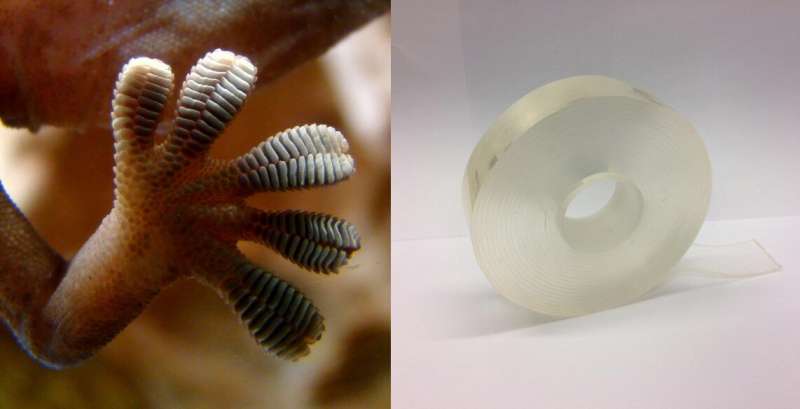How does gecko tape work?

To solve practical issues, sometimes all we have to do is study nature. An often quoted example is that of the gecko, a small animal known for the phenomenal adhesive strength in its feet, which allows it to walk on walls and even ceilings. The phenomenon led to gecko tape, a strongly adhesive DIY tape. Its name suggests that the tape and the gecko stick in similar ways, but are the underlying physics indeed the same?
For the gecko its stickiness, or adhesion, is caused by small pillars in its feet. The electric forces between the molecules in those feet and the surface on which the gecko walks—the so-called Van der Waals forces—allow the gecko to stick to almost any surface. Over the past twenty years, a lot of research was carried out to create synthetic versions of this system—and seemingly with success: one can now buy gecko tape, a double sided tape the name of which suggests that it uses the same principles as gecko feet.
Gecko tape: a closer look
But is that really the case? UvA researchers Hans Terwisscha-Dekker, Marion Grzelka, Simon Lépinay and Daniel Bonn decided to investigate how gecko-like gecko tape really works. To begin with, they studied the surface of the tape using a microscope, and indeed saw small pillars, similar to those in the gecko's feet. Next, they measured the adhesion energy between gecko tape and glass.
It became clear that gecko tape indeed is stickier than normal double sided tape on glass. But is the gecko tape physics also the same as that of the gecko feet? After the researchers had removed the pillars of the gecko tape's surface, there was a surprise: The tape still showed the same amount of adhesion. It seemed something was happening that had little to do with the gecko.
To find out what was going on, the researchers studied the contact surface between the tape and the glass during the experiment—that is: the amount of microscopic surface where the two materials truly touch. It turned out that, with and without the pillars, there was a much bigger contact surface between the gecko tape and the glass than in the case of ordinary double sided tape. Per unit of area of 'true contact,' both kinds of tape were more or less equally sticky.
Softer tape
The conclusion: The pillars on the gecko tape do not play a role in its adhesive strength. This is in stark contrast with the gecko itself, which makes essential use of the surface structure of the pillars. Despite its similarities with the real gecko, gecko tape therefore works in the same way as ordinary tape: The adhesion is caused by glue, not by Van der Waals forces.
Then why does gecko tape work so much better? It turns out that it is the tape's softness that makes its contact surface greater than that of normal tape, causing it to be stickier. That in turn does correspond to what the gecko does: Using the pillar structure, the animal also maximizes the contact surface—even though it uses very different physics to achieve this.
More information: How does 'Gecko tape' work? Hans Terwisscha-Dekker, Marion Grzelka, Simon Lépinay and Daniel Bonn. Biotribology 26 (2021) 100179.
Provided by University of Amsterdam





















